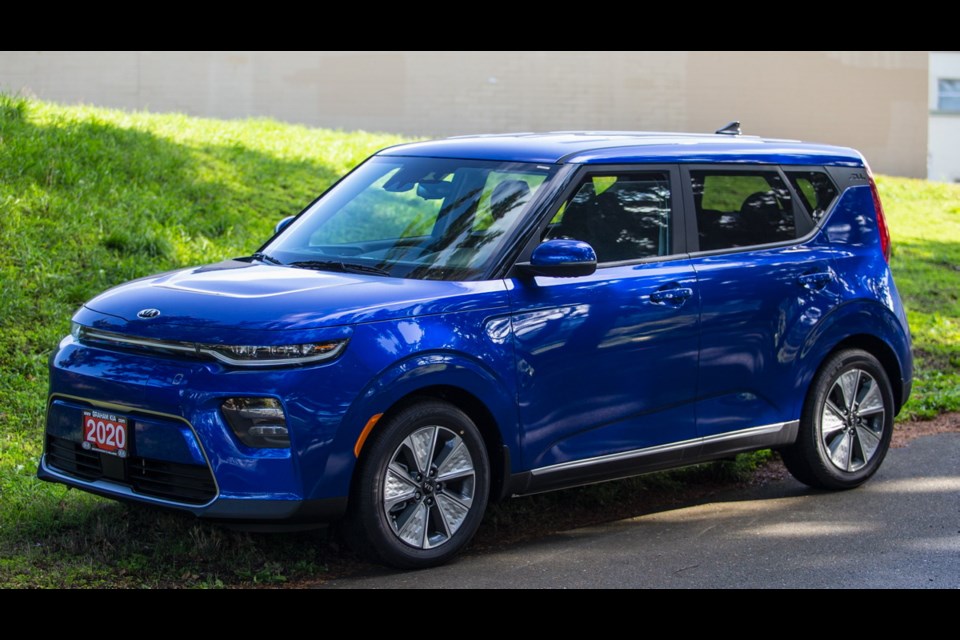Thinking electric? The 2020 Kia Soul EV offers a combination of style, function, power and better range.
This is the second generation of the all-electric subcompact hatchback, which first appeared back in 2014.
Unlike some of its competitors, such as the Nissan Leaf and Chevrolet Bolt, the EV shares all of its body parts with its internal-combustion-engine brothers. The EV version is differentiated by different trim pieces and wheels.
Doing so allows Kia the advantage of spreading out the model’s development costs.
The 2020 model was an opportunity for designers to freshen up the four-door hatchback’s signature boxy design. The driving lights are narrower up front, taking advantage of new LED technology. The taillights are sculptured and quite distinctive, as well.
But the main changes are under the hood. The last Soul EV was a decent vehicle but, like many, suffered from a modest range of about 149 kilometres, driven by a 81.4-kilowatt permanent-magnet synchronous motor.
For 2020, Kia is now offering a choice of two trim models, the Premium at $42,595 and the Limited, with a list price of $51,595.
I drove the former model.
The major differences between the two are power and battery capacity.
The Premium comes with a 39.2-kWh battery mated to a motor that offers 134 horsepower and 291 pound-feet of torque.
The Limited ups the ante with a 64-kWh battery and a more powerful electric motor that produces 201 hp — but torque remains the same.
Kia rates the driving range for the Premium at 248 km and the Limited at 383.
Consumers have been demanding better range when considering an electric vehicle — until they see how much more they have to pay. By offering a choice of two, Kia is following Nissan, which offers two battery capacities as well.
Although the EV Premium and the Nissan Leaf share similar-sized batteries, the Soul can be charged quicker — at just over six hours versus around eight hours — from empty using a Level 2 charger.
You can use a Level 1 charger (which plugs into a regular house socket), but be prepared to wait, as it will take a full 36 hours to fill the battery.
If you are lucky enough to find a 50-kilowatt DC fast charger on the highway, you can be 80 per cent full in 57 minutes.
While the increase in range is welcome, the biggest surprise came in the form of performance.
One typically doesn’t seek out an EV for power, but the 2020 Soul EV delivers an unexpected level of fun.
One feature common in all electric vehicles is their instant torque. With 291 pound-feet of torque available from a standstill, the little Soul scurries from a stoplight like no other economy car. The Leaf, by comparison, only gives you 236 lb.-ft. of torque under similar conditions.
Kia claims the Soul EV can do the 0-100 km/h sprint in under 10 seconds, and my seat-of-the-pants evaluation tells me that this is no exaggeration.
Although it is boxy and tall, it is also a bit of fun on twisty roads — especially in Sport mode (yes, a sport mode on an electric car). Credit can be given to the battery under the floor, which helps with the vehicle’s centre of gravity.
Paddles on both side of the steering wheel are not to change gears, but to choose up to three different levels of brake regeneration. You can choose to coast, with no resistance whatsoever, but you can also come to a full stop without touching your brakes.
Please keep in mind that in your effort to recoup the last kilowatt of power, your brake lights are not activated and the driver behind you won’t be aware of your deceleration intentions.
The designers were busy refining the interior of the Soul, as well. The cabin can best be described as engaging, with all the controls one would want falling easily to hand. The shift knob is history, replaced by a rotary knob that you turn clockwise to engage Drive and counterclockwise for reverse (so simple).
There is a 10.25-inch touchscreen for the infotainment system, which includes navigation, satellite radio, Apple CarPlay and Android Audio.
A wireless phone charger is also standard.
The boxy exterior pays dividends in the interior. While the Soul is a full 285 millimetres shorter than the Leaf, it can still fit in 1,735 litres (61.3 cubic feet) of cargo with the back seats down (more than double the Leaf’s 850 litres).
You also get a host of driving nannies to help keep you safe on the road, including lane-keep assist, rear cross-traffic alert and forward collision-avoidance assist.
The electric-vehicle segment is fast-moving and dynamic. The 2020 Soul EV is an example of how much it can change and improve in a short period of time. Last year’s leader is this year’s also-ran. The new Soul EV is now the one to beat.
THE SPEC SHEET
Type: Subcompact four-door hatchback, front engine, front wheel-drive
Engine: Permanent magnet AC synchronous, 327 V, 134 hp at 2,600 to 8,000 r.p.m., 291 lb.-ft. of torque at 0 to 3,600 r.p.m.
Transmission: Single-speed reduction gear
Battery: 39.2-kWh lithium-ion polymer, 250 Wh/kg density
Recharge time: Level 1, 36 hours, Level 2, 6 hours 10 minutes, 50 kWh DC fast charge, 57 minutes, 100 kWh, 54 minutes
Range (km): 248
Dimensions (mm): Length, 4,195; width, 1,800; height, 1,605; wheelbase, 2,600
Curb weight (kg): 1,572 to 1,612
Price (base/as tested): $42,595/ $44,490 (includes $1,795 freight and PDI and $100 AC tax)
Options: Nil
Tires: 215/55 R17 on alloy wheels
Fuel type: Electricity
Fuel economy (Le/100km): 1.8 city/ 2.3 highway
Warranty: Five years/100,000 km new car, eight years/160,000 km EV components and five years/ unlimited km roadside assistance



